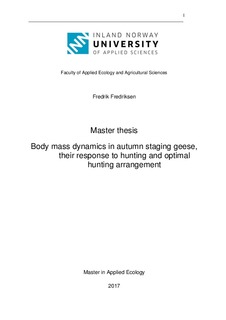| dc.description.abstract | The Svalbard breeding population of Pink-footed Goose Anser brachyrhynchus and the Norwegian breeding population of Greylag Goose Anser anser have increased considerably over the last 30 years while at the same time embracing Nord-Trøndelag in central Norway as a stopover site. Due to increasing agricultural conflicts, population control has been attempted, but so far with limited effect. This study investigates the possibilities to increase the hunting bag when planning the hunt temporally and spatially, and explores the body mass dynamics in the harvest for the two goose species during autumn staging in 2014-2016. The study showed a record number of geese shot each year in the study period compared to the yearly bags in six previous years at the same study area. Most of the geese were shot after one and two hunting free days, whereas two consecutive hunting days gave the lowest average harvest. The average hunting bag went from two geese per hunting event (field being hunted), to almost 20. The spatial hunting response showed that the geese moved to a different field in 77.1% of the occasions on the day after a hunt, with an average distance of 1371 meters from the hunting field. When not exposed to hunting, the geese changed fields in 14% of the following days with an average of 856 meter from the field used the previous day. A total of 1041 geese were shot over the three-year period, and the harvest was dominated by juveniles for both Greylag Goose (58%) and Pink-footed Goose (70%). Average body mass differed significantly for all age and sex-classes within each species except for juvenile males and adult females of Greylag Geese that were not significantly different. Body mass was not related to the date shot in neither of the classes for Greylag Geese. For Pink-footed Geese, both juvenile males and females had a significantly higher body mass when shot later in the season. This indicates that the area is especially important for family groups of Pink-footed Goose, and also suggests that the Greylag Goose use the area to maintain their weight. This study also demonstrates that temporal and spatial organisation of hunting can be used as a tool to increase the harvest, and hence data from the present study can provide useful information for the management of these goose populations. | nb_NO |
